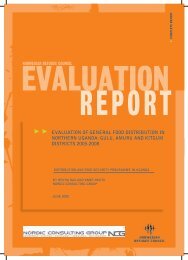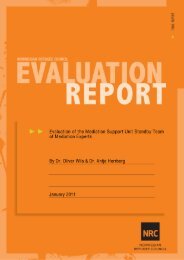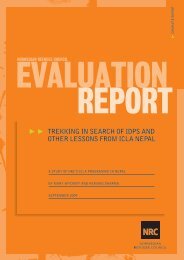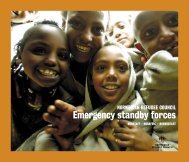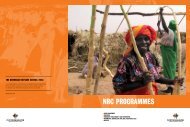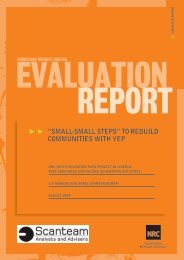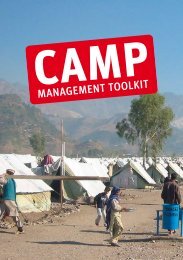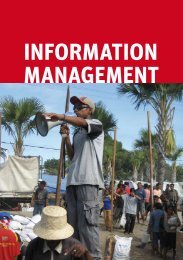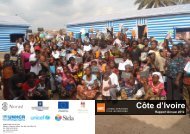Download full report - English version - ProAct Network
Download full report - English version - ProAct Network
Download full report - English version - ProAct Network
You also want an ePaper? Increase the reach of your titles
YUMPU automatically turns print PDFs into web optimized ePapers that Google loves.
directly to sensitisation exercises and could possibly be linked to incentives (e.g.<br />
the provision of warm clothing, or additional blankets). The use of cooking<br />
shelters should result in firewood saving of between 5-10 per cent.<br />
Photo<br />
cooking shelter at Gihinga camp<br />
2.4.3 Cooking Hardware<br />
Beneficiaries are given two metal cooking pots as part of their non-food items<br />
donation. Lids were observed to be used in most cases. The metal pans are relatively<br />
thin and, while they may be appropriate for the boiling of water and frying foods, they<br />
are less appropriate for cooking and simmering food stuffs that take a long time to<br />
cook. Clay pots would be more suitable for the cooking of these food items, e.g.<br />
beans.<br />
Current provisions of cooking hardware thus fail to take into account the nature (i.e.<br />
cooking requirements) of the food-stuffs given as part of the refugee food basket. The<br />
cooking of hard food-stuffs such as beans, for example, requires long, slow cooking.<br />
Thin metal cooking pots waste significant amount of energy when used for this type<br />
of cooking.<br />
Recommendations<br />
Following consultation with beneficiaries, clay pots should be distributed to<br />
beneficiaries as they are more fuel-efficient for the cooking of hard food stuffs,<br />
such as beans.<br />
Wherever possible, NRC should provide opportunities for camp-based milling of<br />
hard food-stuff, where relevant.<br />
2.4.4 Food Rations<br />
Beneficiaries receive dried beans or peas, maize meal, rice and soya as part of their<br />
food rations. Hard, dry foods, however, require a relatively long cooking time, thus<br />
leading to high wood consumption rates.<br />
In some camps, home gardens have been established and fresh vegetables are grown.<br />
Feedback from focus group discussions in each of the three camps suggests that a<br />
proportion of food rations is commonly sold or exchanged for the purchase of<br />
firewood and, possibly, fresh food, where home gardens are absent. This may be<br />
understandable in the case of Gihinga since they are given limited wood rations<br />
but it is unclear why this should be the same at Gasorwe and Musasa, where wood<br />
rations are considered to be in excess of needs. It is likely that this finding has bias in<br />
Gasorwe and Musasa.<br />
Making provisions for beneficiaries to produce their own, fresh food not only<br />
improves their diet and health status, but involves the cooking of foods that take a<br />
relatively short time to cook which, in turn, contributes to a reduction in firewood<br />
consumption. NRC should encourage the refugee communities to consult with host<br />
community members regarding the identification of the most appropriate crops to<br />
15




